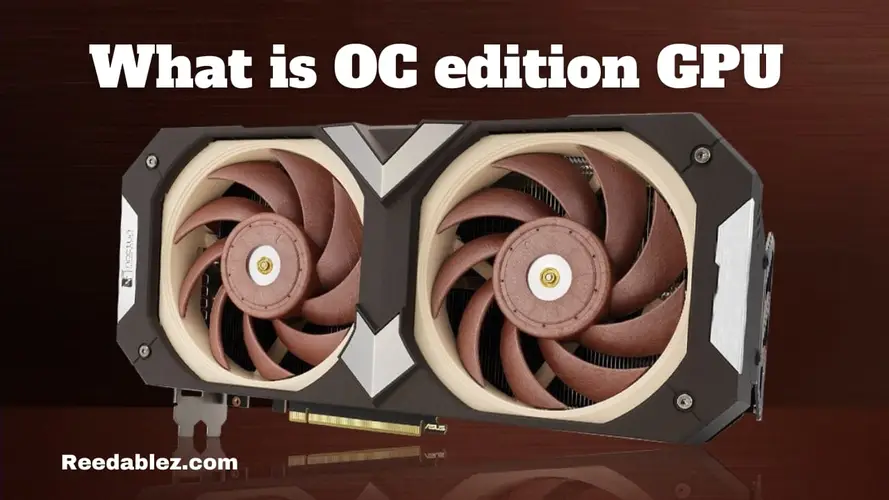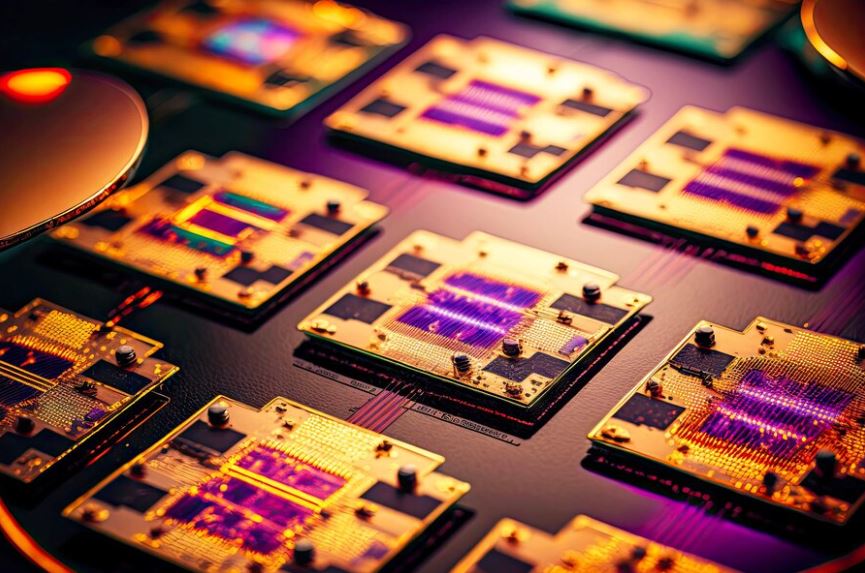How to fix CPU over temperature error? Step by st…
April 14, 2018

In the world of graphics cards, you've probably encountered various acronyms and designations, but one that frequently stands out is "OC Edition." OC, short for overclocked, implies that a graphics card has been pushed beyond its stock performance specifications. However, what exactly is an OC Edition GPU, and why might you consider getting one?
An OC Edition GPU, or Overclocked Edition Graphics Processing Unit, is a graphics card that has been factory-tuned by the manufacturer to operate at higher clock speeds compared to the standard version. This enhances performance, making it ideal for gaming and GPU-intensive tasks like rendering and content creation.
In this comprehensive guide, we will demystify OC Edition GPUs, explain what they are, how they differ from standard GPUs, and help you understand if they are the right choice for your gaming or professional needs.
An OC Edition GPU, or Overclocked Edition Graphics Processing Unit, is a graphics card that has undergone overclocking by the manufacturer. Overclocking is running a hardware component at a higher clock speed or frequency than initially designed for. In the context of GPUs, this means increasing the core clock and sometimes the memory clock to enhance performance.
Manufacturers overclock GPUs to squeeze out extra performance and gain a competitive edge in the market. Overclocking can provide a noticeable boost in frame rates, making your gaming experience smoother and more immersive. An overclocked GPU can significantly reduce rendering time and increase productivity for professional applications like video editing and 3D rendering.

The clock speeds are the primary difference between OC Edition GPUs and their standard counterparts. OC Edition GPUs are designed to operate at higher clock speeds, which can lead to improved performance. These higher clock speeds are achieved through meticulous testing and binning of GPU silicon to ensure stability.
OC Edition GPUs often feature enhanced cooling solutions to handle the increased heat generated by overclocking. These can include more extensive and more efficient fans, advanced heat sinks, and even liquid cooling in some cases. The improved cooling helps maintain stable operating temperatures and prevents thermal throttling.
Manufacturers typically provide custom-tailored firmware for OC Edition GPUs featuring predefined overclocking profiles. These profiles allow users to easily switch between different performance modes, optimizing the GPU for gaming or professional workloads. These factory-tweaked profiles are thoroughly tested to ensure stability and reliability.
For gamers, OC Edition GPUs offer the promise of better gaming performance. You can expect higher frame rates and smoother gameplay in graphically demanding titles. Overclocked GPUs are advantageous when using high-refresh-rate monitors or gaming at higher resolutions.
Professionals who rely on GPU-intensive tasks such as video editing, 3D modeling, or rendering can benefit significantly from OC Edition GPUs. The extra performance can translate into reduced rendering times, improved workflow efficiency, and increased productivity.
While OC Edition GPUs come pre-overclocked from the factory, they often have headroom for further overclocking. This means that users comfortable with manual overclocking can push the GPU even further, achieving additional performance gains.
OC Edition GPUs are generally more expensive than their standard counterparts. The added cost accounts for the enhanced cooling, testing, and the fact that these GPUs are guaranteed to operate at higher clock speeds without overheating or crashing.
Overclocked GPUs consume more power due to their higher clock speeds. Ensuring that your power supply unit (PSU) can handle the increased power requirements is essential. Otherwise, you may experience stability issues.
To accommodate overclocking, OC Edition GPUs often have beefier cooling solutions. While this is necessary for temperature control, it can increase noise levels, especially during heavy gaming sessions.
Before purchasing an OC Edition GPU, consider your specific needs. Are you primarily a gamer, a content creator, or a professional user? Understanding your requirements will help you choose the suitable GPU model and clock speeds.
Various manufacturers offer OC Edition GPUs, each with its design, cooling solutions, and additional features. Research and compare different models to find the one that suits your preferences and budget.
Ensure that the OC Edition GPU you select is compatible with your computer case and power supply. Check the GPU's physical dimensions and power requirements to avoid compatibility issues.
OC Edition GPUs often come with extended warranties and better support, making it essential to review the warranty terms and the manufacturer's reputation for customer service.
To tweak your OC Edition GPU, utilize the manufacturer's software tools. These tools are designed for compatibility and safety with your specific GPU model.
Overclocking increases heat output. Monitor your GPU temperatures closely to prevent overheating, which can lead to instability or reduced component lifespan.
Before committing to an overclocked setting, perform stress tests to ensure stability. Stress testing helps identify any potential issues or instability due to overclocking.
When manually overclocking, make adjustments in small increments, testing stability after each change. This gradual approach minimizes the risk of crashes or damage.
While overclocking, be cautious when increasing the GPU's voltage. Overvolting can generate more heat and might damage the GPU if not done carefully.
Steps to Manually Overclock an OC Edition GPU
Start using manufacturer-provided overclocking software or third-party tools like MSI Afterburner, EVGA Precision X, or ASUS GPU Tweak. These programs offer user-friendly interfaces for adjusting clock speeds and voltage.
Before making any changes, establish a baseline by recording your GPU's default clock speeds and voltage settings. This will help you monitor and compare the effects of your overclock.
Increase the core clock in small increments, typically 10-25 MHz. Run stability tests or benchmarks between each adjustment to ensure the GPU remains stable.
Keep a close eye on your GPU's temperature. Overclocking generates more heat, so your cooling system can handle the added load. If temperatures become too high, it can lead to instability and damage.
You can move on to the memory clock once you've found a stable core clock. As with the core clock, increase it in small increments. Test for stability and monitor temperatures.
Sometimes, you may need to adjust the GPU voltage to achieve higher clock speeds. However, be cautious with voltage adjustments, as excessive voltage can lead to overheating and damage. Increase voltage gradually and carefully.
Use stress testing applications like FurMark or 3DMark to assess the stability of your overclock. If the GPU crashes or produces artifacts, it's a sign that the overclock is unstable. Dial back the settings to a stable configuration.
Benchmark your GPU's performance to measure the improvement gained from overclocking. This lets you compare the before-and-after results and see the actual performance boost.
Most overclocking software allows you to save profiles. Once you've found a stable overclock, keep it as a profile to switch between overclocked and stock settings quickly. You should also read How to change CPU Fan Speed without bios in just 5 minutes.
Manual overclocking can improve performance, enhance gaming experiences, and reduce rendering times for professionals.
Overclocking manually lets you fine-tune the GPU to your specific needs and preferences. You have control over the extent of the overclock and can optimize settings for different tasks.
If you already own an OC Edition GPU, manual overclocking can extend its lifespan and delay the need for a GPU upgrade, potentially saving you money in the long run.
Manually overclocking an OC Edition GPU may void its warranty, depending on the manufacturer's policies. Check your GPU's warranty terms before proceeding.
Overclocking generates more heat, and increasing voltage can exacerbate this. Maintaining adequate cooling and monitoring temperatures is crucial to prevent overheating and potential damage.
Overclocking can lead to system instability, crashes, or artefacts if not done carefully. It's essential to test your overclock for stability and make gradual adjustments.
Back up your important data and files before overclocking. In rare cases, unstable overclocks can lead to system crashes or data corruption.
Keep in mind that not all GPUs are created equal. The extent to which you can overclock your GPU may vary due to the quality of the silicon. Some GPUs may have more overclocking headroom than others.
Overclocking requires some knowledge and patience. If you're new to the process, start with minor adjustments and gradually work your way up as you become more comfortable.
Manually overclocking an OC Edition GPU can be rewarding, providing additional performance gains and personalized settings. However, it's not without its risks, and users should exercise caution, especially when adjusting voltage and monitoring temperatures.
If you're unsure about overclocking or warranty implications, seek guidance from experienced overclockers or professionals.
OC Edition GPUs offer exciting opportunities for improved gaming performance and enhanced professional productivity. However, the decision to opt for an overclocked GPU should be made carefully considering your specific needs and budget. Remember that overclocking carries some risks, and it's crucial to understand the potential drawbacks and take precautions to ensure the longevity and stability of your system. By making an informed choice and following best practices, you can harness the extra power of an OC Edition GPU to elevate your computing experience.
"OC Edition" stands for "Overclocked Edition." It refers to graphics cards that have undergone overclocking by the manufacturer to boost their performance.
Overclocking increases a GPU's clock speeds, resulting in improved performance. It leads to higher frame rates and better gaming or rendering capabilities.
Yes, OC Edition GPUs generally come at a premium compared to standard models. The added cost accounts for enhanced cooling and guaranteed higher clock speeds.
Yes, overclocked GPUs consume more power due to their higher clock speeds. Ensure your power supply unit (PSU) can handle the increased power requirements.
OC Edition GPUs may produce more noise due to their beefier cooling systems. However, the extent of noise varies between different models and manufacturers.
Overclocking carries some risks, including potential overheating and instability. To minimize these risks, use manufacturer-provided software, monitor temperatures, stress test the GPU, make adjustments in small increments, and be cautious with voltage adjustments.
Comments
Write a comment